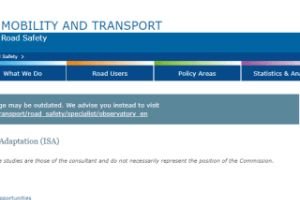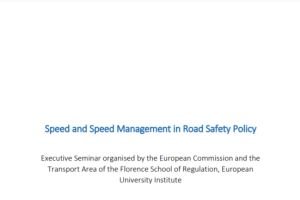
Overview
Reducing Speeding in Europe (PIN Flash 36)
In-vehicle technology vital to tackling speeding in Europe
Speeding remains a significant problem in many European countries according to a research published by the European Transport Safety Council (ETSC). The researchers looked at the numbers of vehicles found to be driving above the speed limit on different road types in the countries that were able to provide such data.
On urban roads, where 37% of all EU road deaths occur, the researchers found that between 35% and 75% of vehicle speed observations were higher than the legal speed.
On rural non-motorway roads, where 55% of all road deaths in the EU occur, between 9% and 63% of vehicle speed observations were higher than the speed limit.
On motorways, where 8% of all road deaths in the EU occur, between 23% and 59% of observed vehicle speeds were higher than the speed limit.
Speed is a major factor in overall road safety performance. Excessive and inappropriate speed is accountable for about one third of fatal collisions and is an aggravating factor in most collisions.
While reducing speeding will require a combination of measures including higher levels of enforcement, improved infrastructure and credible speed limits – the authors singled out Intelligent Speed Assistance (ISA), a driver assistance system available today, as the key in-vehicle safety measure for tackling the problem.
On 21 February, 2019, the European Parliament’s Internal Market (IMCO) Committee will vote on critical new EU vehicle safety standards which include a proposal to make overridable ISA a mandatory technology on all new vehicles from 2022. It is estimated that this single measure could eventually reduce deaths on European roads by 20%. The entire package of vehicle safety measures is expected to prevent more than 25,000 deaths between 2022 and 2037, but only if it is adopted in its entirety.
The report also highlights speed-related measures currently being implemented across EU Member States. In particular, it noted some progress on reducing speeds on rural roads. France recently cut the speed limit on rural roads without median barrier from 90km/h to 80km/h. An initial analysis by the research institute Cerema showed 116 fewer road deaths on rural roads limited to the new 80km/h speed limit compared to the 2013-2017 average on the same roads for the months July to December, the period since the new limit was introduced. Spain has also announced a shift from 100km/h to 90km/h for its high speed rural road network while Flanders, the northern region of Belgium, also switched from 90km/h to 70km/h in 2017.
Some of the countries with the best safety records in Europe have lower standard speed limits on rural roads. Including Sweden at 70km/h with 27 deaths per million inhabitants. Norway (26), Switzerland (26), Denmark (37) and the Netherlands (37) all set the limit at 80km/h.
The researchers report that a combination of mobile roadside police checks together with automated stationary enforcement, including fixed and average speed or time-over distance cameras, has proved to be an effective tool in addressing speeding.
Did you know?
82% of Road Crash Fatalities and Injuries in the economically productive age groups (15 - 64 years.)
82% of Road Crash Fatalities and Injuries in the economically productive age groups (15 - 64 years.)


